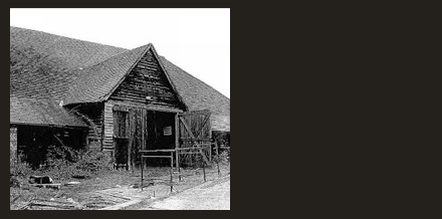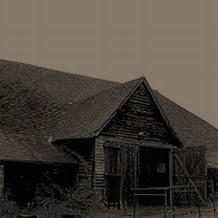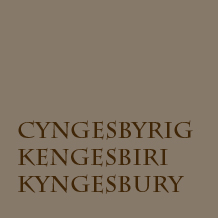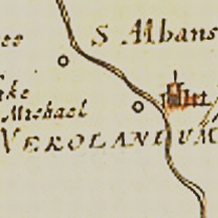The Manorial Barn at Kingsbury, St. Michael's
A Report by Adrian Gibson, MBE, Consultant on Historic Buildings, commissioned by the Society of St. Michael's & Kingsbury.
October 2004
The barn is one of six medieval barns that have been identified as being built in the late fourteenth century by St. Albans Abbey in a programme of general improvement of their manorial properties.
Five of the barns have been published in volumes of 'Hertfordshire Archaeology' (vols. 2, 3, 4 & 7). Still standing are those at Croxley Hall, Rickmansworth, Abbots Langley (Ovaltine Factory site) and Kingsbury - plus one as yet not generally known at Langleybury, adjacent to the big house and part of a farm group. The barn at St. Julians is dismantled and awaits rebuilding at the Chilterns Open Air Museum, and another at Parkbury was destroyed by fire in 1973.
Interest in these barns has been furthered by several related facts - they make a recognisable group in the vicinity, they share distinctive construction techniques and in particular two of them, Croxley and Kingsbury, are particularly referred to in the St. Albans Abbey records as having money spent on them by Abbot John Moote who was abbot between 1396 - 1401.
The five years concerned is a short time to do the work. Tree ring dating (dendrochronology) has recently shown that the timber for the Croxley barn was felled in 1397, which fits the record. At Kingsbury, however, the wood was felled in 1373/4, before Moote was Abbot - but he did hold office in the monastery.
Although research is incomplete as yet, it does appear that this remarkable group of barns was constructed in the late fourteenth century as a deliberate policy. A similar upgrading of barns, a little later, in the early fifteenth century has been noted at the two similar great barns at Cressing Temple, in Essex, the manor then being held by the Knights Hospitaller. Historically this was a time of change when monastic houses were leasing out their holdings in order to take rent rather than running the manors themselves.
Technically the features that link these barns are the following. (However, not every barn has exactly the same construction but clearly they have enough to demonstrate their unity of design.)
- They are all aisled with 'passing-braces' running from the outer wall posts, past the aisle-ties and the arcade posts and finishing jointed to the tie-beams and not going further up to the roof members.
- They all have very distinctive, accurately cut full height grooves cut into the inner edges of the principal members. These grooves about 1/2" x 5/8" deep (12 x 16mm), are set at 1" (25mm) in from the frame's outer face. The 'common' studs of the walling are set in from the outer face the same amount, about 1", clearly to support from the back the cladding housed in the grooves.
- Crown-post roofs are used but only in the vicinity of the wagon porches. The rest of the roofs are simply 'collar-rafter' type, half-hipped at their ends.
- Longitudinal members - arcade-plates and wall-plates have splayed and tabled scarf joints along their lengths.
- Some of the barns have their aisle-ties expanded at the end where they meet the arcade-posts, giving a stronger joint at a point of weakness.
- Two of the barns, Croxley (standing) and St. Julians (in store) have 'arcade-shores' at half bay intervals, looking superficially like base-crucks and serving the same purpose supporting the heavily loaded arcade-plates. At Croxley one removed and lying on the floor, shows no actual joint at the head except a simple 'bird-mouth' that works like the top of a washing line pole - as a cradle.
- A feature that has preserved the barns till now is that their timber frames are set on high 'dwarf' walls, made at Croxley and Kingsbury of flint and sandstone cobble gathered off the surrounding fields. This keeps the sills and lower framing clear of rising damp thus preventing rotting and necessary renewal commonly seen in other barns. These walls would clearly add to the expense of construction and are a manifestation of excellence.
Particular evidence at Kingsbury
It is at the Kingsbury Barn that evidence of the barn's outer cladding is preserved. In common with other old barns it is now weatherboarded, the original infilling having been removed. However, in the two end wall frames high up under the tie-beams, fragments of the original construction survive. It consists of thin laths set horizontally with equal width gaps set within the continuous grooves. These laths pass over the outer faces of the slightly inset studs (upon which they are presumably nailed). This lath armature is then covered with a thick layer of daub inside. Outside it is presumably finished flush with the principal framing and covered with a thin layer of plaster of Paris for water proofing. (These details can be checked when scaffolding is set up).
The barn would have looked like contemporary houses with exposed framing and flush infill panels. The difference is that instead of using simple wattle and daub the housed and nailed laths would be much stronger and prevent the panel from drifting out of position in time and so prevent water from seeping in and rotting the stored sheaves of corn - a very thorough job!
The other special feature seen in the Kingsbury Barn is the clear proof that the gabled porch is contemporary with the main construction and not a later feature, which is often so with early barns. Commonly a large porch is added in post-medieval times, presumably to cope with bigger haywains that could be temporarily held there ready to be unloaded. The wall plates of the porch, one bay wide run right back into the barn as continuous lengths to become aisle-ties jointed to the arcade-posts and the whole is clearly of one build. Also at the outer projecting corners where the doors are, 'angle-ties' link the wall plates to the outer tie-beam. Angle-ties can be either early or late. Here they are clearly early and original and still doing their job. The ultimate proof that the porch is original is the presence of finely cut vertical grooves for lath and daub infill cut into the principal vertical members - exactly similar in style to the barn's main framing.
Although the barn has lost its rear aisle, probably in the eighteenth century, (the back wall being weatherboarded on the line of the arcade posts), the building is of the utmost importance. Not only is it the nearest of these barns to the Abbey but also the two features, panel infilling and the contemporary nature of the porch, are unique in the clarity with which they are seen.
[text below black bold]
Both must be preserved and visible in any reworking of the structure. The barn stands as a model for the interpretation of the others. Within the barn apotropaic (anti-witch) marks are apparent. These are part of seventeenth century superstition and should be carefully preserved for posterity to see.
Adrian Gibson, 22/10/04



